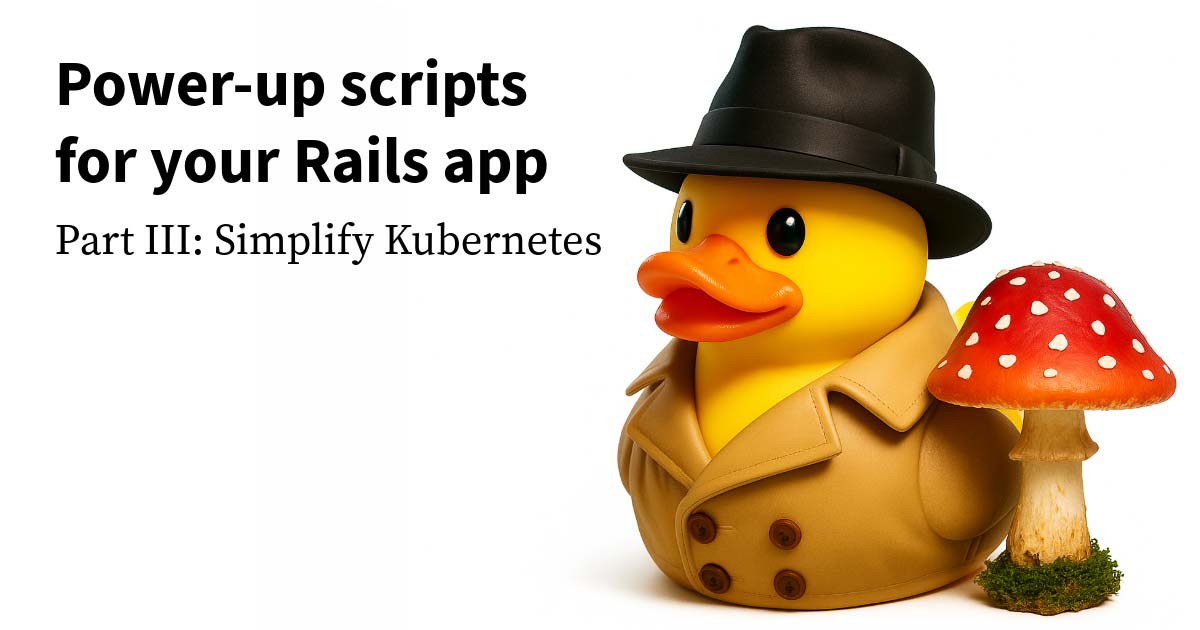Docker’s ubiquity presently is not without warrant: pretty much every deployment process I’ve seen in the past five years of my career has leveraged it to generate images for deployments.
Amazon’s ECS, Google’s Cloud Run, and Kubernetes all have images and containers at their core. Cloud native is the de-facto standard. So, accordingly, my present project (a serverless backend leveraging AWS Lambda) uses Docker to package the functions that are invoked.
This generally works great—what we author in our local environments corresponds to what we see in our cloud development environments, in staging, and in production. Our typical developer lifecycle is to author a change locally, test it locally, deploy the image to an image repository, and then use that image to deploy a container to a dev cloud environment to validate the changes in a serverless environment. However, one component of this process was a recurring thorn in our side.
Docker builds can be slow.
Particularly on this project, making a change could take upwards of a few minutes when rebuilding the Docker image to then deploy a container to a dev cloud environment. So, make a change, break your flow until the build finishes, and then forget everything you were doing. Or worse, get distracted.
With some downtime between tasks, I wanted to fix this to improve the developer experience of the project.
Getting the lay of the land
Iterative improvement is the name of the game, so rather than accepting a slow Dockerfile, I wanted to understand what the problem was and then investigate how to resolve it. This project’s codebase contained a large number of Lambda functions and their source code with their dependencies managed via npm workspaces. Further, a common module provided shared functionality across the codebase: writing to a database, making API calls, processing errors, and so forth.
$ tree .
.
├── Dockerfile
├── package-lock.json
├── package.json
├── src
│ ├── common
│ │ ├── module1.js
│ │ ├── module2.js
│ │ ├── package.json
│ │ ├── src
│ │ │ ├── module1
│ │ │ │ └── index.js
│ │ │ ├── module2
│ │ │ │ ├── index.js
│ ├── lambda1
│ │ ├── app.js
│ │ ├── package.json
│ │ └── src
│ │ ├── handler.js
│ │ ├── handler.spec.js
│ │ └── index.js
│ ├── lambda2
│ │ ├── app.js
│ │ ├── package.json
│ │ └── src
│ │ ├── handler.js
│ │ ├── handler.spec.js
│ │ └── index.jsOur Dockerfile copied in the ENV-provided Lambda source and the common directory, installed its dependencies, ran a build with esbuild, and copied the output build artifact into the deployment image:
ARG LAMBDA_DIRECTORY_NAME
# Builder image
FROM public.ecr.aws/lambda/nodejs:18 as builder
ARG LAMBDA_DIRECTORY_NAME
WORKDIR ${LAMBDA_TASK_ROOT}
RUN npm install -g npm@9
COPY package.json package.json
COPY package-lock.json package-lock.json
COPY src/common src/common
COPY src/${LAMBDA_DIRECTORY_NAME} src/${LAMBDA_DIRECTORY_NAME}
RUN npm ci
RUN LAMBDA_DIRECTORY_NAME=${LAMBDA_DIRECTORY_NAME} npm run build
# Deployment image
FROM public.ecr.aws/lambda/nodejs:18
ARG LAMBDA_DIRECTORY_NAME
WORKDIR ${LAMBDA_TASK_ROOT}
COPY --from=builder ${LAMBDA_TASK_ROOT}/src/${LAMBDA_DIRECTORY_NAME}/dist ${LAMBDA_TASK_ROOT}/dist
ENTRYPOINT /lambda-entrypoint.sh dist/app.lambdaHandlerDocker: Like an onion
A docker image is a set of layers, with each instruction in the Dockerfile generally translating to a new layer. Docker caches these layers on repeated builds and does its best to rebuild only what has been changed, making your build faster.
This is like an ordered list, a dependency chain, or an onion (if you prefer). Changing a file that is referenced in the first instruction (at the start of the list) of your Dockerfile means everything after must be re-executed. Changing a file that is referenced in the last instruction (at the end of the list) of your Dockerfile means only that instruction must be re-executed.
So, I wanted to know where the time was being spent in building the image. Using the docker buildx build command, I was able to see the amount of time spent running each instruction:
$ docker buildx build --build-arg LAMBDA_DIRECTORY_NAME=lambda1 .
[+] Building 34.2s (14/15)
=> [internal] load build definition from Dockerfile 0.0s
=> => transferring dockerfile: 721B 0.0s
=> [internal] load .dockerignore 0.0s
=> => transferring context: 2B 0.0s
=> [internal] load metadata for public.ecr.aws/lambda/nodejs:18 30.2s
=> [internal] load build context 0.1s
=> => transferring context: 1.43MB 0.1s
=> [builder 1/9] FROM public.ecr.aws/lambda/nodejs:18@sha256:50f22b7077c7fbb7be2720fb228462e332850a4cd48b4132ffc3c171603ab191 0.0s
=> CACHED [builder 2/9] WORKDIR /var/task 0.0s
=> [builder 3/9] RUN npm install -g npm@9 5.1s
=> [builder 4/9] COPY package.json package.json 0.0s
=> [builder 5/9] COPY package-lock.json package-lock.json 0.0s
=> [builder 6/9] COPY src/common src/common 0.0s
=> [builder 7/9] COPY src/lambda1 src/lambda1 0.0s
=> [builder 8/9] RUN npm ci 29.1s
=> [builder 9/9] RUN LAMBDA_DIRECTORY_NAME=lambda1 npm run build 0.6s
=> [stage-1 3/3] COPY --from=builder /var/task/src/lambda1/dist /var/task/dist 0.0s
=> exporting to image 0.0s
=> => exporting layers 0.0s
=> => writing image sha256:a8095a1267ddf2a08d53525231565087e1d575a38b41eb9c6eddb331d977c591 0.0sThe problem
It looked like the bulk of our time was spent running npm ci.
The majority of our logic and functionality lived in our common directory, so that was the code that most frequently changed.
Whenever we made a change to common, our npm ci build instruction was re-executed. Further, since common functions as a shared library across our code, and this Dockerfile was common to all our Lambda functions, any dependent Lambdas would also have to be rebuilt in order to deploy.
So, every time we made a code change in common, for every Lambda, we had to re-invoke npm ci, leading to our slow builds, and our frequent coffee breaks.
The solution
Remember how Docker is like an onion?
We only needed to re-execute npm ci when a dependency was added, modified, or changed. So, modifying our Dockerfile to copy package.json and package-lock.json, executing the npm ci step, and then copying over our source code should result in the slow step being cached for our general case (modifying common).
We can observe this change from the following Dockerfile:
ARG LAMBDA_DIRECTORY_NAME
# Builder image
FROM public.ecr.aws/lambda/nodejs:18 as builder
ARG LAMBDA_DIRECTORY_NAME
WORKDIR ${LAMBDA_TASK_ROOT}
RUN npm install -g npm@9
COPY package.json package-lock.json ./
COPY src/common/package.json src/common/package.json
COPY src/${LAMBDA_DIRECTORY_NAME}/package.json src/${LAMBDA_DIRECTORY_NAME}/package.json
RUN npm ci
COPY src/common/src src/common/src
COPY src/common/module1.js \
src/common/module2.js \
./src/common/
COPY src/${LAMBDA_DIRECTORY_NAME}/src src/${LAMBDA_DIRECTORY_NAME}/src/
COPY src/${LAMBDA_DIRECTORY_NAME}/app.js src/${LAMBDA_DIRECTORY_NAME}/
RUN LAMBDA_DIRECTORY_NAME=${LAMBDA_DIRECTORY_NAME} npm run build
# Deployment image
FROM public.ecr.aws/lambda/nodejs:18
ARG LAMBDA_DIRECTORY_NAME
WORKDIR ${LAMBDA_TASK_ROOT}
COPY --from=builder ${LAMBDA_TASK_ROOT}/src/${LAMBDA_DIRECTORY_NAME}/dist ${LAMBDA_TASK_ROOT}/dist
ENTRYPOINT /lambda-entrypoint.sh dist/app.lambdaHandlerThe results
Installing a new dependency still required rerunning npm ci, meaning it took a second (or thirty of them more often). However, modifying code in common no longer triggered npm ci to re-execute. So, we could author and deploy code changes to our dev cloud environment much more quickly and not break our flow state as a result:
$ docker buildx build --build-arg LAMBDA_DIRECTORY_NAME=lambda1 .
[+] Building 0.5s (18/19)
=> [internal] load build definition from Dockerfile 0.0s
=> => transferring dockerfile: 1.29kB 0.0s
=> [internal] load .dockerignore 0.0s
=> => transferring context: 2B 0.0s
=> [internal] load metadata for public.ecr.aws/lambda/nodejs:18 0.4s
=> [builder 1/13] FROM public.ecr.aws/lambda/nodejs:18@sha256:50f22b7077c7fbb7be2720fb228462e332850a4cd48b4132ffc3c171603ab191 0.0s
=> [internal] load build context 0.1s
=> => transferring context: 475.68kB 0.0s
=> CACHED [builder 2/13] WORKDIR /var/task 0.0s
=> CACHED [builder 3/13] RUN npm install -g npm@9 0.0s
=> CACHED [builder 4/13] COPY package.json package-lock.json ./ 0.0s
=> CACHED [builder 5/13] COPY src/common/package.json src/common/package.json 0.0s
=> CACHED [builder 6/13] COPY src/lambda1/package.json src/lambda1/package.json 0.0s
=> CACHED [builder 7/13] RUN npm ci 0.0s
=> CACHED [builder 8/13] COPY src/common/config src/common/config 0.0s
=> CACHED [builder 9/13] COPY src/common/src src/common/src 0.0s
=> CACHED [builder 10/13] COPY src/common/module1.js src/common/module2.js src/common 0.0s
=> [builder 11/13] COPY src/lambda1/src src/lambda1/src/ 0.0s
=> [builder 12/13] COPY src/lambda1/app.js src/lambda1/ 0.0s
=> [builder 13/13] RUN LAMBDA_DIRECTORY_NAME=lambda1 npm run build 0.9s
=> [stage-1 3/3] COPY --from=builder /var/task/src/lambda1/dist /var/task/dist 0.0s
=> exporting to image 0.0s
=> => exporting layers 0.0s
=> => writing image sha256:716193841c31688bfd4a4b08f81735accb2d5f047c9d33fd1d31461b935ecfe4 0.0sDevs are happiest when they’re working and not waiting, so I considered this a win for our team’s health and for our productivity. If you’re suffering from slow builds, I invite you to examine your Dockerfiles and think about how to order the instructions to optimize for caching slow steps.
Join the conversation about this post on our N.E.A.T community: How have you applied small changes to speed things up?
Not a N.E.A.T. community member yet? More info.











